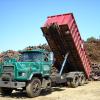Those rear wheel spokes are flat, indicating they are cut down steel wheels with rubber tires added on by the local blacksmith. Original rubber wheels were round spoke, as are the ones up front. During 30s and 40s tractors commonly had rubber tires up front for easier steering, this helped cut down on cost as rubber rears were super expensive. The ones with the spoke flywheels were VERY rare as they were only made for the first year or two, hence their value. If it is old enough to have the brass s/n plate that adds to the value, as I recall they were done away with by about 1935. Most electric start models were made after 1938 or 1939 (I believe, don't hold me to it) so it will most likely have the galvi s/n plate. The sheet metal, fenders, intake and exhaust stacks, all appear to be correct for the period and in good shape, those are usually the biggest factors determining the tractor's value after the condition of the engine or transmission. As for what it's worth, I stopped following the two cylinder John Deere market almost 18 years ago (ironically the same time I discovered trucks and girls. . . . . . . hmmmmmm funny how that worked out ) so what it's worth is anyone's guess, but I'd go out on a limb and say $5000 is probably the high end of the spectrum, D models like this one were so incredibly common since their production spanned over 20 years with only a couple major changes and this one is a common example. As I recall the electric start diesel two cylinders and the unstyled G's always commanded the highest dollar amounts right up there with spoke flywheel D's, also certain GP models were big $$, all the other models were pretty commonplace. This is all from memory in the back of my cobweb filled brain box so if I missed anything please point it out




